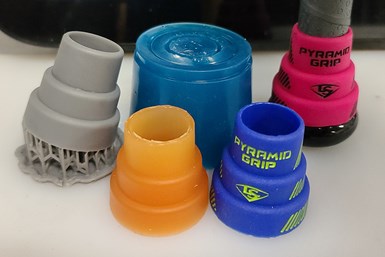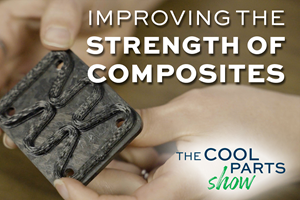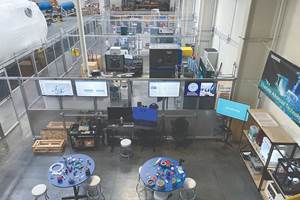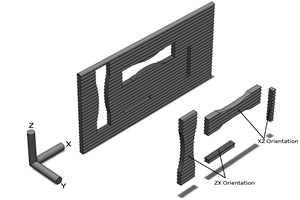Louisville Slugger Uses Formlabs Technology to Accelerate Innovation
Louisville Slugger relies on Formlabs’ Form 3 stereolithography 3D printer to create both prototypes and manufacturing aids for designs of the composite and aluminum bats swung by youth and collegiate players.
The new BBCOR Atlas is a prime example of a premium product designed with the advanced innovation techniques used at the Louisville Slugger innovation center. Photo Credit: Formlabs
Louisville Slugger has added additive manufacturing (AM) to its toolbox as it works to continuously improve its baseball bats and equipment. At the Slugger Innovation Center in Roseville, California, product designer John Steel uses a combination of traditional and modern tools for the design and manufacturing of aluminum and composite baseball bats.
“If you’re not 3D printing, you’re not going to keep up,” Steel says. He relies on Formlabs’ Form 3 stereolithography (SLA) 3D printer to create both prototypes and manufacturing aids for prototype designs of the composite and aluminum bats swung by youth and collegiate players around the world.
Since 1884, Louisville Slugger has been manufacturing baseball bats and equipment for Major League Baseball as well as college, high school and youth teams. Players today are always looking for an edge — that little tweak that will help them swing faster and hit harder. Louisville Slugger encourages that drive to improve at any level with its Slugger Innovation Center which focuses on equipment improvement.
At the Slugger Innovation center, engineers and designers have access to whatever tools they need to develop the best products possible. That enables them to merge the traditional with the modern, using desktop 3D printing as well as lathes, a CNC metal shop, a composites workshop and more. “We’re able to rapidly produce prototypes for quick iteration and testing. We use it every week and, if we’re working through a new design, we’ll iterate on it every day,” Steel says.
3D printing can speed up the iterative process, helping move a new innovation from concept design (light grey, 3D printed part, far left) to finished part made with traditional manufacturing (pink part, far right). Photo Credit: Formlabs
The speed of iteration enables the Slugger team to regularly release new products, and keep up with demand for bats suitable for all different levels of play. “3D printing is a great tool to reduce the amount of time it takes to get to market,” Steel says. “You can use it from prototyping to problem-solving. Prototyping the initial design, to problem-solving the final manufacturing.”
There’s constant competition in the market, even for a brand with such a storied history as Slugger. Steel and the innovation team are continuously iterating and pitching new ideas, and the Form 3 helps them get those ideas through to the next stage even faster.
“I’ll have an idea, design it and send it to the printer in 30 minutes, then bring it to the next meeting. 3D printed visual aids are worth their weight in gold,” Steel says. He also says that 3D printing improves team understanding of the product development process and can help eliminate any crossed wires down the road. That team cohesion enables Steel and other designers to keep their workflow streamlined and productivity high.
“Oftentimes when looking at 3D renderings, we lack scale,” Steel says. “Printing parts helps when attempting to reference how something compares in size along with being able to test ergonomics and fitment into existing products.”
Though integral for prototyping, Steel also uses the Form 3 for other applications, such as creating silicone molds and some other types of manufacturing aids. The diverse material library enables a wide range of possible workflows and enables Steel to gain greater control over different processes. “The Form 3 also allows us to leverage the breadth of materials available for other processes, like forming mold positives in silicone to backpour in urethane, silicone, or an epoxy,” Steel says. The molds are used to create final-stage prototypes, which include all the eventual types of material, such as urethane or epoxy, that will be used in the final, traditional manufacturing process.
Before, if the company wanted to get silicone parts made, it would have to get aluminum tooling, but now it can 3D print the positive geometry, then backpour in silicone, cut the silicone mold apart and then use the resulting negative to create other types of parts, such as functional prototypes.
“SLA has a very fine fidelity and holds tight tolerances. This not only provides us with parts within spec but it also alleviates much of the postprocessing required on the mold positive,” Steel says. “When molding, you want as smooth of a surface finish as possible on your mold positive to ease part removal from the mold. Some texturing is okay, but the grooving caused by layer stackup is where things get tricky and the quality of the Form print layers is never an issue. Plus, postprocessing these materials is super easy.”
Outsourcing is a common and typically necessary part of any manufacturing process at some stage. But when multiple stages have to be outsourced, timelines can get pushed back and product development will stagnate. Taking control of even one more part of the process can give greater control to the designer. In the silicone molding example, iterating the positive and practicing the silicone pour process can illuminate flaws in the design that would otherwise take weeks of waiting and testing to uncover when using an outside vendor.
“3D printers are the easiest technology to make something quickly — you’re able to sketch it out then produce it yourself, rather than have to hand it off to a specialist and wait to get it back to then test,” Steel says.
Looking forward, Steel is working on expanding the number and range of ways to use 3D printing, including in manufacturing. “Creating tools with the printer can be more valuable than creating parts,” he says.
Though Slugger already uses 3D printed tools like the silicone mold positives, the problem-solving ability of 3D printing means that there’s more to come. “Good equipment makes the sport more fun to play, and that’s what the Innovation Center is all about,” Steel says. “We’re using technology like the 3D printers to keep improving, and we’re constantly looking at what’s next.”
- Learn more about Formlabs’ SLA Printers for optimizing 3D printing workflow. The Form 3+ and Form 3B+ were designed to provide speed, quality and workflow efficiency.
- Learn how Formlabs is involved in another favorite pastime for young and old. Hasbro is using Formlabs 3D printing technology to create custom action figures. Hasbro is ushering in a new era of mass customization in consumer entertainment with its Selfie Series figures using 3D printing to manufacture personalized action figures at scale.
Related Content
3D Printed Preforms Improve Strength of Composite Brackets: The Cool Parts Show Bonus
On this episode, we look at a pin bracket for the overhead bin of an airplane made in two composite versions: one with continuous fiber 3D printed reinforcements plus chopped fiber material, and one molded from chopped fiber alone.
Read MoreAdvancing Additive Manufacturing With a CATCH and Release Approach
Solutions for energy efficiency, sustainability, part repair and more are developing at Siemens’ Charlotte Advanced Technology Collaboration Hub (CATCH) in North Carolina.
Read More3D Printed Human-Operated End-of-Arm Tooling Promotes Safety and Throughput
Toolmaker and injection molder Zero Tolerance developed a manual tool to enable an operator to quickly place inserts into a mold.
Read MoreEvaluating the Printability and Mechanical Properties of LFAM Regrind
A study conducted by SABIC and Local Motors identified potential for the reuse of scrap reinforced polymer from large-format additive manufacturing. As this method increases in popularity, sustainable practices for recycling excess materials is a burgeoning concern.
Read MoreRead Next
Profilometry-Based Indentation Plastometry (PIP) as an Alternative to Standard Tensile Testing
UK-based Plastometrex offers a benchtop testing device utilizing PIP to quickly and easily analyze the yield strength, tensile strength and uniform elongation of samples and even printed parts. The solution is particularly useful for additive manufacturing.
Read MoreCrushable Lattices: The Lightweight Structures That Will Protect an Interplanetary Payload
NASA uses laser powder bed fusion plus chemical etching to create the lattice forms engineered to keep Mars rocks safe during a crash landing on Earth.
Read More3D Printed Polymer EOAT Increases Safety of Cobots
Contract manufacturer Anubis 3D applies polymer 3D printing processes to manufacture cobot tooling that is lightweight, smooth and safer for human interaction.
Read More






















